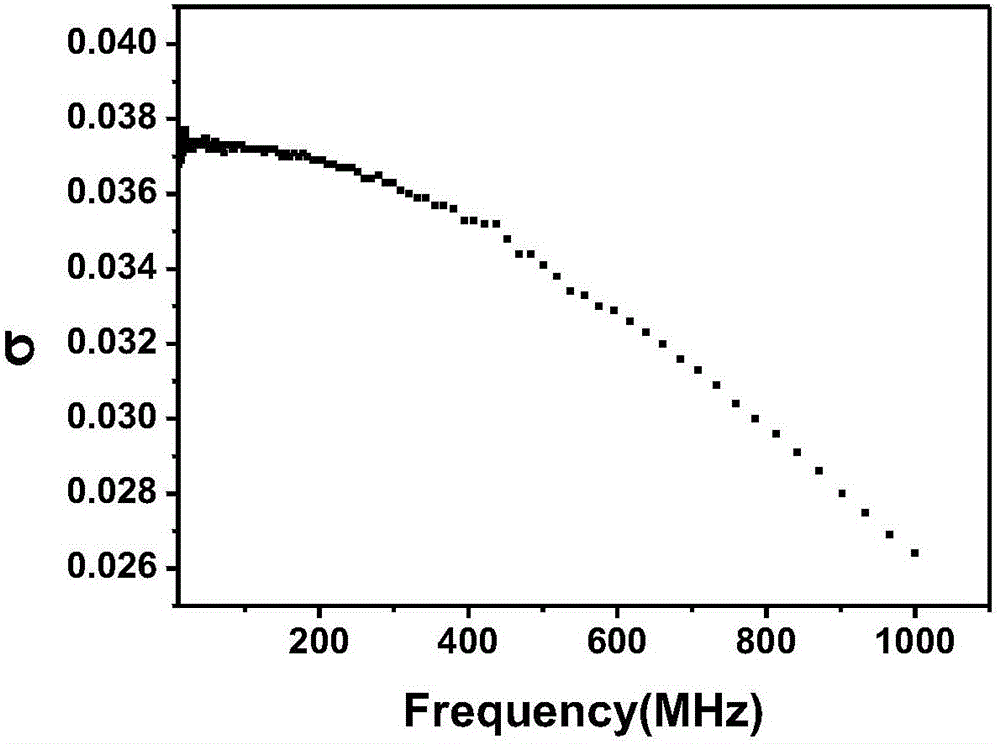Method for preparing negative permittivity material from graphene, carbon nanometer tubes and phenolic resin
A negative dielectric constant and carbon nanotube technology, which is applied in the field of negative dielectric constant material preparation, can solve the problems of high dielectric loss and high conductivity, and achieve the effects of reduced dielectric loss, excellent thermal conductivity, and low density
- Summary
- Abstract
- Description
- Claims
- Application Information
AI Technical Summary
Problems solved by technology
Method used
Image
Examples
Embodiment 1
[0027] Put weighing paper on the electronic balance, take graphene with a clean key and put it on the electronic balance, weigh 0.025g graphene, pour the graphene into the container; then take a piece of weighing paper and put it On the electronic balance, use another clean key to take the carbon nanotubes to the electronic balance, weigh 0.025g of carbon nanotubes, and pour the weighed carbon nanotubes into the same container as the graphene; Put the paper on the electronic balance, use a clean key to take the phenolic resin to the electronic balance, weigh 0.70g of the phenolic resin, and pour the weighed phenolic resin into the same container. Pour the mixed powder in the container into the ball milling jar, and perform ball milling for 5 minutes, then stop the ball milling, remove the ball milling jar, pour the evenly mixed powder into the mortar, and drop 4 drops with a dropper with a volume fraction of 2.5 % PVA solution, grind for 5 minutes. Pour the powder into the ta...
Embodiment 2
[0029] Put weighing paper on the electronic balance, take graphene with a clean key and put it on the electronic balance, weigh 0.0335g graphene, pour the graphene that has been weighed into the container; then take a piece of weighing paper and put it on the electronic balance On the electronic balance, use another clean key to take the carbon nanotubes to the electronic balance, weigh 0.0165g of carbon nanotubes, and pour the weighed carbon nanotubes into the same container as the graphene; Put the paper on the electronic balance, use a clean key to take the phenolic resin to the electronic balance, weigh 0.70g of the phenolic resin, and pour the weighed phenolic resin into the same container. Pour the mixed powder in the container into the ball milling jar, and perform ball milling for 5 minutes, then stop the ball milling, remove the ball milling jar, pour the evenly mixed powder into the mortar, and drop 4 drops with a dropper with a volume fraction of 2.5 % PVA solution,...
Embodiment 3
[0031] Put weighing paper on the electronic balance, take graphene with a clean key and put it on the electronic balance, weigh 0.0165g graphene, pour the graphene into the container; then take a piece of weighing paper and put it in On the electronic balance, use another clean key to take the carbon nanotubes to the electronic balance, weigh 0.0335g of carbon nanotubes, and pour the weighed carbon nanotubes into the same container as the graphene; Put the paper on the electronic balance, use a clean key to take the phenolic resin to the electronic balance, weigh 0.70g of the phenolic resin, and pour the weighed phenolic resin into the same container. Pour the mixed powder in the container into the ball milling jar, and perform ball milling for 5 minutes, then stop the ball milling, remove the ball milling jar, pour the evenly mixed powder into the mortar, and drop 4 drops with a dropper with a volume fraction of 2.5 % PVA solution, grind for 5 minutes. Pour the powder into t...
PUM
| Property | Measurement | Unit |
|---|---|---|
| diameter | aaaaa | aaaaa |
| thickness | aaaaa | aaaaa |
Abstract
Description
Claims
Application Information
 Login to View More
Login to View More - R&D
- Intellectual Property
- Life Sciences
- Materials
- Tech Scout
- Unparalleled Data Quality
- Higher Quality Content
- 60% Fewer Hallucinations
Browse by: Latest US Patents, China's latest patents, Technical Efficacy Thesaurus, Application Domain, Technology Topic, Popular Technical Reports.
© 2025 PatSnap. All rights reserved.Legal|Privacy policy|Modern Slavery Act Transparency Statement|Sitemap|About US| Contact US: help@patsnap.com


